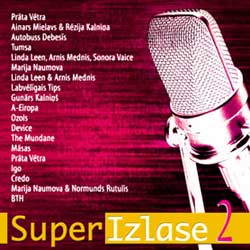
For Latvian popular music, 2001 was another memorable year. Old faces returned (such as Prāta Vētra, Credo and Labvēligais Tips), new faces emerged (for example, The Mundane and Māsas). Autobuss debesīs released their first record, rap music continued to develop in Latvia, and dance music became more diverse. Where should the uneducated listener start? Now that broadcasters such Radio SWH and Latvijas Radio 2 are available on the Internet, a listener anywhere in the world can hear the newest sounds in Latvian music. That, or they could purchase the latest summary of Latvian music, the second installment of the SuperIzlase series, SuperIzlase 2.
As they did in 2000, the record companies of Latvia came together with a common goal: to sell more records. How better to do this than with a compilation of all the hits of 2001 on one compact disc? Participants in the 19-track SuperIzlase 2 include MICREC, UPE Recording Co., Baltic Records Group, Platforma Records and Rīga Records.
As always with these kinds of compilations, you get a widely divergent group of songs. It is doubtful that there will be one listener who likes all the tracks, but ideally all listeners should like at least one. Though there are many performers who are alumni of the first SuperIzlase release, about 10 see their first appearance in the series.
Rock fans should have their appetite sated with this collection, as there is plenty on here that could appeal to them. Even if you are like me and had already heard (and bought) most of the rock releases that are represented on here, there is still a good chance that there will be something new on here for you.
Prāta Vētra (BrainStorm) contributes two tracks from their 2001 release, Kaķēns, kurš atteicās no jūras skolas. There is the English-language “Maybe” (oftentimes the English language tracks make me cringe, but this I like). There is also the “acoustic version” of their song “Visskumjākā parāde uz mūsu ielas,” which is different than the version on the album. What’s nice about this version is that it is played on guitar, an instrument not heard often on Kaķēns.
Other rock releases include two songs with music by Imants Kalniņš: a duet betwen Ainars Mielavs and Rēzija Kalniņa, “Apturi mani,” and the Autobuss debesīs song “Ir tikai tveice.” From Tumsa’s latest release, we get the song “Lai būtu tā” (probably the most “listener-friendly” song from their latest album). Labvēlīgais tips’ lyrics continue to become even stranger. The group is represented by the song “Koka klucis Konstantīns”—guaranteed to cause puzzled faces on listeners everywhere. Credo also provide their most “accessible” track, “Tur aiz mākoņiem ir saule,” from their latest album.
Because these kinds of compilations are usually geared towards younger listeners, there is plenty of pop and dance and other such things. Latvian Eurovision representative Marija Naumova appears on two tracks. The first is “Hey Boy, Follow Me,” a catchy, somewhat Latin-sounding song. The secong is a duet with Normunds Rutulis, “Kūko, kūko dzeguzīte,” which strikes me as being a song for the particularly young listener. “Kūko” also features the music of Raimonds Pauls.
Latvia’s own Mariah Carey, Linda Leen, appears on two duets with Arnis “Spaceman” Mednis. The first is “Noktirne,” the music for which I was very surprised to find out was not written by Raimonds Pauls, although it sounds very much like him. Famous Latvian soprano Sonora Vaice also adds some vocal melodies to “Noktirne.” Leen and Mednis ditch Vaice for their next song, the super-slick ballad, “Not to Fall Again.”
Heartthrob Gunārs Kalniņš’ entry for this album is the song, “Pērles un dimanti,” another super-slick pop song that should keep his legions of pre-teen female fans happy.
Dance group A-Eiropa perform the song “Meitenes Rīgā,” while Igo also submits a super-poppy song, “Ir labi kopā būt,” that sounds more like it belongs in the 1970s than the 21st century. Another favorite of the younger crowd is Latvian rapper Ozols, who performs “Bokss.” Also in the rap vein is the song “Rītdiena” by the group Device. BTH, formerly known as Braithouse, also provides a dance song, “Last Christmas.”
One reason anyone buys these kinds of collections is to find out if there is anything new that they had not heard before. In my case, though I had already heard most of the music that I would have liked, there were a couple of things that got my interest. I had not heard of the rock group The Mundane, but I really liked their song “Nav viegli būt tev.” I also like the more poppy group Māsas and their song “Dāvā laimi.” I will have to investigate these groups more on my next sojourn to Latvia.
The liner notes are pretty sparse. Last year they at least had pictures of the groups, but not this year. Also I think it would help in marketing to name the album from which the track was taken and to include any Web sites for the bands or the record labels.
How times have changed since the days of Soviet-style elections even in the music world, when you had the choice of Raimonds Pauls, or… well… Single party systems are a bit of a drag, aren’t they? It is still amazing how varied the Latvian music world has become and what selection a listener has, be they old, young or just very fussy. For a quick overview of where Latvian music stands today check out SuperIzlase 2. It may lead you to discover much of the great music and the great bands in Latvia today.
Details
SuperIzlase 2
Various artists
MICREC, 2001
© 1995-2024 Latvians Online
Please contact us for editorial queries, or for permission to republish material. Disclaimer: The content of Web sites to which Latvians Online provides links does not necessarily reflect the opinion of Latvians Online, its staff or its sponsors.




